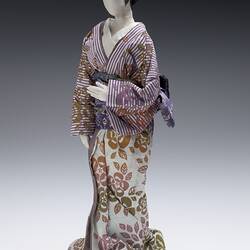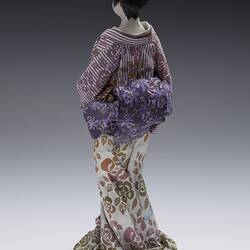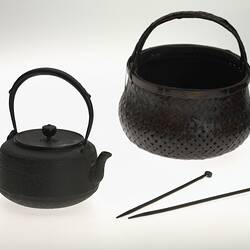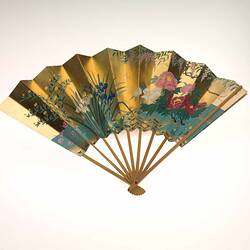Summary
Japanese Shimotsuke paper doll called Akiyo, a samurai wife, characterised in the novel 'Fuyu no shirube' by Yuzaburo Otogawa (2002). It is based on Edo period style (1615-1868). The doll is one of several dolls made in Melbourne by Masumi Hiraga Jackson between 1998 and 2007.
Paper doll-making in its simplest form dates back over a thousand years in Japan. They were first produced as a cleansing process made to remove bad aura away from people. By the 8th century, a unique method of crepe paper production was introduced to the Shimotsuke region. The technique has been refined over time, using flexible crepe paper which is easily moulded into various shapes. The colours and patterns hand-dyed on the paper reflect kimono designs, while the characters are taken from Japanese folk stories and Noh theatre. Shimotsuke-paper doll making requires delicate and refined work. The body of a doll is made from paper and cotton, and then it is dressed with many layers of individually prepared paper kimono and pasted together with glue. Shimotske is a hard wearing fibrous paper hand-rolled and dyed by a family business in Japan (the sole supplier of this paper in Japan) from whom Masumi directly orders the paper. Her dolls have been displayed at the National Gallery of Victoria, the Geelong Arts Centre, Victoria and Japanese Consulate in Melbourne.
Masumi Hiraga Jackson was born in Nirasaki, Japan in 1935, one of ten children. Her mother Kino was a skilled weaver who wove and sewed silk kimono, a highly regarded skill. Masumi studied at universities in Tokyo (Japanese cultural studies) and Canberra (English and linguistics) and in 1984 married an Australian. She immigrated to Melbourne in 1985 but sadly her husband died two years later. Masumi decided to remain in Australia and immersed herself in traditional Japanese cultural practices such as Noh theatre, Ikebana and Shimotske paper doll-making. She performs and instructs these art forms in Australia and overseas, and returns to Japan every year to see her family, undertake Ikebana lessons, practise her Noh performance and to purchase materials for doll-making.
Physical Description
The paper doll is wearing a kimono in patterned and coloured tones of purple and brown, with a purple obi around the waist. The hair is black and worn up. The doll is made from a dyed crepe paper, made flexible for doll making through a process of squeezing and pleating the paper. Patterns reflect kimono patterns. White tissue paper and cotton is used to make the head, body and other body parts.
Significance
The significance of this item is its place within a collection which represents the personal and cultural value of maintaining cultural and artistic traditions within a new environment. The act of migration has profound implications for both immigrant and receiving country, with many migrants actively finding ways to introduce their cultural practices in an environment unfamiliar with such activities. This collection can help to explore the successful shift in Australian government policies from the cultural assimilation of the 1950s to the more broadly embracing multicultural policies from the 1970s. Moreover, its significance also lies in the intrinsic artistic value of the finely crafted Shimotsuke dolls, and the cultural heritage value of the collection of kimono.
More Information
-
Collection Names
-
Collecting Areas
-
Acquisition Information
Donation from Mrs Masumi Hiraga, 21 Mar 2007
-
Maker
Mrs Masumi Hiraga, Melbourne, Greater Melbourne, Victoria, Australia, 1998-2007
-
Classification
Cultural identity, Ethnicity - creative practice, Paper craft
-
Category
-
Discipline
-
Type of item
-
Overall Dimensions
17.5 cm (Width), 19 cm (Depth), 50.5 cm (Height)
-
Keywords




